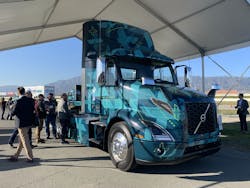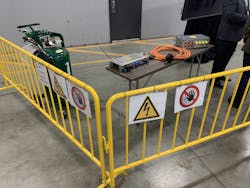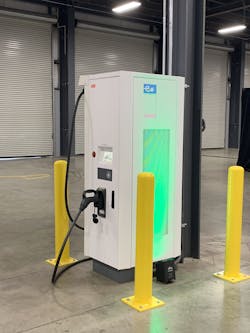Volvo LIGHTS establishes path to managing service and maintenance of electric heavy duty trucks
How will fleets handle the service of electric trucks?
Global truck manufacturer Volvo Trucks looks to answer this question through its recently-announced Volvo LIGHTS program, a collaborative holistic approach to manage end-to-end adoption of full battery-electric trucks for commercial use.
Volvo showcased its Volvo LIGHTS program, which stands for Low Impact Green Heavy Transport Solution, earlier this week in Fontana, California. The Volvo LIGHTS program highlighted the evaluation of power needs and establishing charging infrastructure for shops, the service and maintenance for these vehicles, and the second-life use of the truck’s batteries.
At the event, Volvo also introduced its VNR full battery-electric Class 8 tractor. The truck manufacturer had five trucks on hand – three Class 8 tractors and two straight trucks – and attendees were able to test drive the trucks at the Auto Club Speedway. Volvo plans to enter full commercial production by the end of 2020. The VNR electric will be built at the company’s New River Valley plant in Virginia.
As part of that approach, Volvo representatives stressed the importance of assessing the full total cost of ownership (TCO) when it comes to evaluating the possibility of adopting electric trucks into a fleet.
Sales and service will be part of that evaluation. The truck manufacturer has plans to create a template that will allow other Volvo dealerships and fleets the means to have a standard process for servicing electric vehicles.
Start early, plan ahead
When it comes to adding electric trucks to a commercial fleet, collaboration with the customer is key, said Brett Pope, director of electric vehicles for Volvo Trucks North America.
“How do we justify the investments that will be required for an electric product?” Pope said. “We need to work through [to determine] the total cost of ownership and what it costs to operate, what are the maintenance schedules, and the main barriers for entering.”
This first starts with an evaluation of the customer’s needs, such as business operations, duty cycles, load patterns, and routes.
Pope shared a tool the company has developed to help fleets better predict the remaining charge based on real-time data collection and can help fleets take action to adjust the route or contact the driver as needed. It provides the average speed of the vehicle, how much energy has been used, and the remaining battery left. Data points include items such as topography, traffic congestion, distance to travel, etc.Pope stressed the importance of preparing shops for managing high-voltage trucks. This means after a fleet purchases an electric truck, dealers must be prepared to provide after-sales support and service.
“We don’t want to make things unique. We [plan to] integrate the electric truck into our toolbox and our dealer management programs,” Pope said. This means dealerships will need to educate technicians ahead of any electric trucks ever entering the shop.
Don’t reinvent the wheel
By relying on tested and proven processes, Volvo hopes to shape and update the methods used for servicing electric trucks. The Volvo aftermarket team looked to existing diesel truck service processes as a template to adjust to full battery-electric trucks.
“When we first started the [Volvo] LIGHTS project, [the] initial direction was to keep as much as we have possible,” said Jeff Zody, aftermarket project manager for Volvo Trucks North America. “We already have dealer networks, parts distribution centers, and tools. That’s all in place. We wanted to integrate the electric truck into the existing platform.”
Because the electric VNR regional haul Class 8 tractor is based off its diesel counterpart, current Volvo customers running the diesel VNR will already be somewhat familiar with the product. Case in point, the VNR electric has a similar interior cab layout and design and the same active and passive safety systems.
“We already do diagnostics, we already do connected vehicles, we already have repair information,” Zody said. “We have all those systems in place. There’s nothing new we haven’t found so far. We can just use our current systems and integrate. It looks promising we’ll be able to do that.”
While utilizing existing platforms currently in use by Volvo dealers, the integration of connected vehicles and diagnostic processes means they’re developing predictive maintenance practices from the start.
In preparation for addressing differentiators such as spare parts, Zody said the aftermarket team has been establishing processes for ordering parts from the supplier and parts distribution centers, and has a pilot inventory on-hand at TEC Equipment Fontana while the shop prepares to service electric trucks.Additionally, new repair methods and technical information must be created to manage high voltage and the different systems on the electric truck compared to its diesel counterpart, Zody said.
“As this goes along throughout the year, we're going to learn more and we're going to understand ‘Can we actually have the same or common maintenance schedule?’ for example, or is it going to be different,” said Zody.
Safety and training imperative
While the Volvo team looks to take advantage of current processes and products already in place, there will be some added training and safety considerations.
Volvo completed a full risk assessment both to address service needs in the field, as well as service in the shop.
In the field, the team has been working to educate emergency first responders such as emergency medical services (EMS), as well as fire or sheriff departments. This process has become more complex than originally thought, Zody explained. This is because different departments do not always share the same district. Add to that, varied routes for the electric trucks means numerous first responders will require education on how to manage responding to a high-voltage vehicle situation.
“As you get further into this and do more investigation, you realize these issues are fairly complex and involved,” Zody said. “We’re getting this fleshed out now so we’re prepared.”
For the shop environment, the team evaluated items such as battery and parts handling needs, proper signage and communication in the shop including high-visibility safety barriers, diagnostic equipment required, and safety procedures such as lockout / tagout lockboxes used on items like the traction voltage system, which includes 600V orange cables that could cause severe electric shock if not managed properly.
Addressing the changing needs of the service technician
Zody shared the proposed supervisory structure of managing the electric trucks as they enter the shop. “This new technology coming into the workshop will create a need for properly trained technicians,” he said. This starts with a workshop manager overseeing all shop safety, a lead technician managing work activity approvals, and a well-trained service technician responsible for completing maintenance and repairs.
The workshop manager would ensure that all technicians are properly trained and have the right equipment to service electric trucks. They also observe to ensure all proper safety schedules are completed.
The lead technician will play an integral role as the person commissioning and decommissioning the vehicle. In other words, as an electric truck comes into the shop, the lead technician is the one controlling access to the vehicle, taking measures to ensure safe and proper service procedures.
“Once the vehicle is made safe, the [service] techs can come in and perform whatever duty needed, and then come back out,” Zody explained. “The lead tech will come back in and make sure it’s done in a safe state.”
As it relates to training, Volvo has partnered with two local California area colleges which have established curriculums for heavy duty electric vehicle service. Instructors from San Bernardino Valley College and Rio Hondo College in Whittier, California, shared their experience and plans with training future technicians.
The curriculum includes items such as:
- Understanding common electric vehicle terminology and language
- Understanding and performing high-voltage safety standards, for voltages of 400V or more
- Understanding proper personal protective equipment required for working on high-voltage systems
- Describing the common components in a full battery electric vehicle drivetrain
- Demonstrating proper procedures to isolate high voltage for diagnosis and service repairs
Overall, once the student is trained they would have the ability to disassemble the parts, test the equipment, and also have effective written and oral communication with a co-worker and customer to explain the repair and what was done.
San Bernardino Valley College instructor Kenny Melancon shared that the educational facility is working to recruit high school students to learn the terminology and some processes for electric vehicle service. "We call it concurrent enrollment,” Melancon said. “To build a relationship to teach at the high school level with knowledgeable instructors. They can earn college credits.”
“As new technology comes out and shows up in a facility, it can be challenging to understand how to service the vehicles,” said John Frala, an instructor at Rio Hondo College, of servicing battery-powered trucks like the new VNR electric. “We’re training our technicians live on this product right now. Graduates in May [of 2020] will have experience on this product already.”
Real-world starting point
Volvo hosted the Volvo LIGHTS event at the TEC Equipment Fontana dealership, located 50 miles west of Los Angeles. TEC Equipment operates 28 Volvo and Mack Trucks dealerships throughout the west coast, primarily along the U.S. Interstate 5 corridor. Their technician team will also be one of the first to assist with servicing and developing maintenance programs for the electric VNR truck.
While establishing a service template designed for widespread electric vehicle adoption is already in progress, Volvo is working to train a small pool of current technicians who will be managing the service of these vehicles at the TEC Fontana dealership from the start.“The TEC program allows us to build our methods, tools, and processes to get feedback here to create the template on what’s required to sell this product,” Pope said. “Once we have it mostly figured out, we can move to the next dealership and the next region and we’ll be able to do it at a much faster pace.”
As an efficiency, shops may want to have a dedicated bay – for instance, TEC Fontana chose to dedicate two bays where electric truck service will be completed. Installed near these bays are two ABB Terra 50 kW charging stations, which can charge the truck in less than 90 minutes. The bays will also include the necessary safety equipment such as safety railings.
“The goal here is really to try to get a template created so what we build is pretty comprehensive from an aftermarket standpoint,” Zody said. “Then ideally, it would be nice to just duplicate that wherever the vehicles are running.”
As the Volvo LIGHTS program picks up momentum through regional haul applications, Pope shared that the plan is to ultimately develop battery-electric heavy duty trucks for long haul.
“We’ll learn together the range, the energy management system work, [and] how to incorporate logistics of charging into daily operations,” Pope said. “We’ll target 75-175 mile ranges of operations [for the initial VNR electric launch]. As the technology improves and the charging infrastructure develops in public spaces, we’ll grow into long haul as our ultimate objective.”
Expansion into other applications, such as long haul operations, will not only require a well-established recharging infrastructure, but will also require a breakthrough in battery technology to allow for higher capacity in a smaller footprint.
Beyond the battery technology advancements, the Volvo LIGHTS program has set in motion a holistic approach that aims to help pave the way for a more widespread adoption of commercial electric trucks.
About the Author
Erica Schueller
Media Relations Manager | Navistar
Erica Schueller is the Media Relations Manager for Navistar.
Before joining Navistar, Schueller served as Editorial Director of the Endeavor Commercial Vehicle Group. The commercial vehicle group includes the following brands: American Trucker, Bulk Transporter, Fleet Maintenance, FleetOwner, Refrigerated Transporter, and Trailer/Body Builders brands.
An award-winning journalist, Schueller has reported and written about the vehicle maintenance and repair industry her entire career. She has received accolades for her reporting and editing in the commercial and automotive vehicle fields by the Truck Writers of North America (TWNA), the International Automotive Media Competition (IAMC), the Folio: Eddie & Ozzie Awards and the American Society of Business Publication Editors (ASBPE) Azbee Awards.
Schueller has received recognition among her publishing industry peers as a recipient of the 2014 Folio Top Women in Media Rising Stars award, acknowledging her accomplishments of digital content management and assistance with improving the print and digital products in the Vehicle Repair Group. She was also named one Women in Trucking’s 2018 Top Women in Transportation to Watch.
She is an active member of a number of industry groups, including the American Trucking Associations' (ATA) Technology & Maintenance Council (TMC), the Auto Care Association's Young Auto Care Networking Group, GenNext, and Women in Trucking.
In December 2018, Schueller graduated at the top of her class from the Waukesha County Technical College's 10-week professional truck driving program, earning her Class A commercial driver's license (CDL).
She has worked in the vehicle repair and maintenance industry since 2008.




